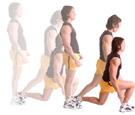Skiing Holiday Fitness
Skiing for most people is in the form of a 7 day skiing holiday once a year in the pursuit of good snow. Time should be given prior to your skiing holiday to concentrate on your fitness in order to get the full benefits from only a short period on the snow.
Aim to do these exercises twice a week, with at least 2 days rest between sessions. The main muscles used during skiing are those of your quadriceps (thighs), however a total body workout needs to be done, as all of your muscles will be used, and as soon as one of them becomes tired, your skiing ability will suffer.
The use of a Swiss Ball will certainly improve your core strength, whilst aiding your stabilty and balance on the slopes, there are over 200 different abdominal exercises and specific training programs for all levels on the Swiss Ball within our members area.
Performing aerobic exercises to improve your fitness will reduce your risk of injury, as you will be able to maintain and focus upon your skiing technique. Look at designing yourself a simple circuit, whereby you will do a 30 - 45 seconds light jog / run, followed by 8 -15 of each exercise in a controlled manner.
On your first time around perform just the leg circuit, then the leg and upper body and finally all 3 exercises. Make sure that you do the lap jog / run after each leg / upper body or abdominal circuit.
|
|
||
|
|
 |
|
|
Two footed squat thrusts - aim for a 12 inch jump.
|
Walking lunge forward - changing lead leg.
|
Alternate leg squat thrusts - count reps on 1 leg only.
|
|
|
||
 |
 |
 |
|
Wide arm press-up. Take elbows out to your sides.
|
Normal press ups, aim to keep a straight line through your back.
|
Close Hand - Aim to keep your thumbs touching each other.
|
|
|
||
|
|
|
 |
|
Normal sit ups, keep your chin off your chest.
|
Alternate elbows to knees - count reps on one side only.
|
Alternate hand to foot - count reps one side.
|
Start by performing the exercises with adequate rest between each different exercise until you get fitter. Once you can do the exercises and repetitions comfortably, work on increasing the number of different circuit exercises you can perform, or change the exercises for ones that are slightly harder - if you don't then your fitness will not improve - look within our members area for over 1,000 different exercises plus a multitude of training programs.
Dependent upon your fitness level, you may only wish to perform the first 1 - 2 exercises, and add a new one as your fitness level increases / or at the beginning of a new week.
For those of you that are fitter, you should be able to run for 1 minute on each exercise for 2 sets.
Working with a partner and to music will certainly help motivate you. Remember that you do not have to do all the exercises listed above.
For competent skiers, and for those persons of a good fitness level, the plyometrics circuit will certainly improve your leg strength, resulting in greater skiing capabilities. Along with the above circuit or weight training sessions, you should aim to do some form of aerobic training ideally 3 times a week.
The fitter you become, the more time you can spend skiing, and less chance you have of having a serious accident. With skiing being a sport in which you have sessions of moderate to high rate levels for periods ranging from 1-5 minutes plus, followed by periods of rest, i.e. travelling back up the slope, the best exercise to perform would be interval work.
The best aerobic equipment, would be skiing machines or steppers, however any aerobic equipment will benefit you.
Once you feel comfortable with your level of aerobic fitness, aim to implement some interval work into your sessions. These can be performed on any equipment or running / steppers / bike.
|
|
||||||
|
5 minutes easy. RPM 60 |
2 minutes hard. RPM 80+ |
2 minutes RPM 60 |
90 seconds RPM 80+ |
2 minutes RPM 60 |
1 minute RPM 80+ |
5 minutes RPM 60 |
|
|
||||||
|
5 minutes easy. |
200 meters hard. |
2 minutes |
400 meters |
3 minutes |
200 meters |
5 minutes |
The above examples are only guidelines to illustrate ways in which you can increase the difficulty. The bike sample shows that by increasing the level from 4 to 6 / 7 / 8 you will only need to work for a short period keeping the speed the same in order to raise your heart rate.
The same would work for the running machine, however here we have used distance as the interval guide. The faster you run, the shorter the distance you can cover, likewise placing any upward gradient into your run will make it harder.
Remember to give your body sufficient time to recover, i.e. for our 400 metre run, we have an extra minute to allow the heart rate to recover, as well as doing the run at a slower speed.
Only persons of a reasonable fitness level should perform these types of workouts, if you feel faint or ill in any way, stop immediately.
As mentioned earlier, most accidents occur in the afternoon, this is due to both poor fitness levels in skiers, and the fact that as a recreational sport, most participates avoid both eating and drinking regularly. Maintain your food and fluid intake whilst on the slopes, preferably hot meals or such foods as flapjacks, and warm drinks.
Train well before you go skiing, and you will get more out of your sport.



